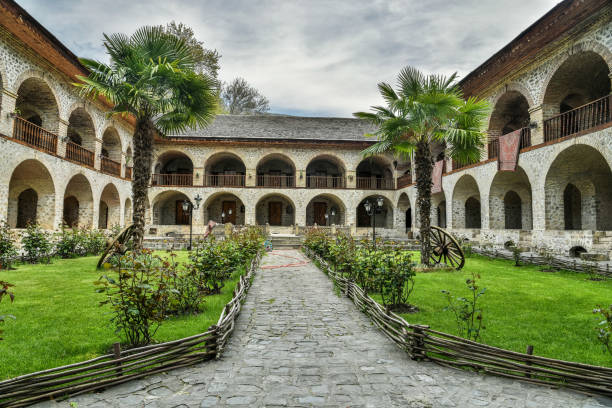Historic Sheki is a small but beautiful town located along the ancient Silk Road that will charm both your heart as well as your stomach. Sheki is well known for its local cuisine, sweets, and many beautiful remnants of the once prosperous Silk Road. A HISTORY OF SHEKI AZERBAIJAN The history of Sheki already starts in the 1st century BC when it was one of the major cities of the Albanian state. We are not talking about the country Albania in Southeastern Europe, but Caucasian Albania. An ancient kingdom that ruled a large area of what is now Azerbaijan. In its long history, Sheki saw many rulers come and go. The Caucasus has always been the battleground of different empires. Sheki once belonged to the Romans, Parthians, Arabs, Mongolians, Persians, and the Russians. Wat put Sheki on the map of the Silk Road was its strategic location in between Tbilisi and Baku as well as its silk production. Sheki had the perfect climate for mulberry trees that silkworms need to grow. Much of the city’s wealth came from the highly prized Sheki silk fabrics using a unique embroidery style called Tekelduz. Most famous were also the silk women headscarves called Kelaghayi. As Sheki grew into a center of trade and commerce, other handicrafts and arts flourished too. The city was an important production center for pottery and ceramics. Another famous art is Shebeke. The multi-colored stained glass mosaics are beautiful, but even more impressive knowing that it is made without glue or nails. The city’s cultural heritage from the Silk Road is still visible in its architecture. Ancient caravanserais, wealthy merchant homes, churches, mosques, and the beautiful palace of the Shaki Khans. The occasional old Lada is the only sign that Sheki also belonged to the Soviet Union. Even then it was
Historic Sheki
is a small but beautiful town located along the ancient Silk Road that will charm both your heart as well as your stomach. Sheki is well known for its local cuisine, sweets, and many beautiful remnants of the once prosperous Silk Road.
A HISTORY OF SHEKI AZERBAIJAN
The history of Sheki already starts in the 1st century BC when it was one of the major cities of the Albanian state. We are not talking about the country Albania in Southeastern Europe, but Caucasian Albania. An ancient kingdom that ruled a large area of what is now Azerbaijan.
In its long history, Sheki saw many rulers come and go. The Caucasus has always been the battleground of different empires. Sheki once belonged to the Romans, Parthians, Arabs, Mongolians, Persians, and the Russians.
Wat put Sheki on the map of the Silk Road was its strategic location in between Tbilisi and Baku as well as its silk production. Sheki had the perfect climate for mulberry trees that silkworms need to grow. Much of the city’s wealth came from the highly prized Sheki silk fabrics using a unique embroidery style called Tekelduz. Most famous were also the silk women headscarves called Kelaghayi.
As Sheki grew into a center of trade and commerce, other handicrafts and arts flourished too. The city was an important production center for pottery and ceramics. Another famous art is Shebeke. The multi-colored stained glass mosaics are beautiful, but even more impressive knowing that it is made without glue or nails.
The city’s cultural heritage from the Silk Road is still visible in its architecture. Ancient caravanserais, wealthy merchant homes, churches, mosques, and the beautiful palace of the Shaki Khans. The occasional old Lada is the only sign that Sheki also belonged to the Soviet Union. Even then it was still a major silk production center.
Sheki is now part of the creative cities network because of its long tradition in artisan handicrafts. Since 2019, it’s historic center is also recognized as a UNESCO World Heritage site.
THE BEST THINGS TO DO IN SHEKI AZERBAIJAN
1. THE SUMMER PALACE OF THE SHAKI KHANS
2. THE WINTER PALACE OF THE SHAKI KHANS
3. SHEKI MUSEUM OF FOLK AND APPLIED ARTS
4. SHEKI FORTRESS
5. SHEKI KARAVAN SARAI
6. JUMA MOSQUE
7. THE OLD TOWN
8. SOVIET ARCHITECTURE
9. THE WORLD WAR 2 MEMORIAL
10. KISH AND THE ALBANIAN CHURCH
12. SHEKI MARKET
13. VISITING A TEA HOUSE
14. TASTING SHEKI HALVA
15. EATING SHEKI PITI

